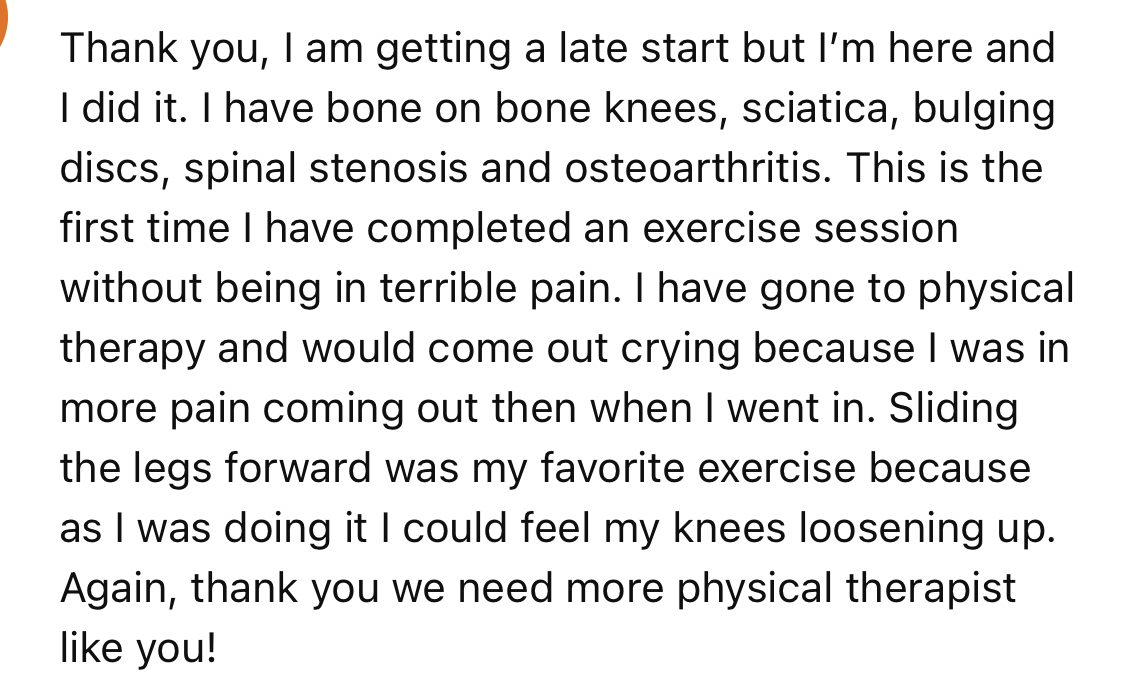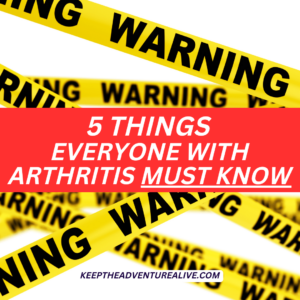Spinal stenosis can make daily activities difficult due to pain, weakness, and/or stiffness. As it turns out, exercises for spinal stenosis are most effective when they include flexion (bending forward). This is a pain relieving position for the condition. You can accomplish safe spinal flexion with bodyweight support bands and a kitchen counter if you are just starting. Various research studies have examined the effectiveness of exercise on lumbar spinal stenosis and have concluded that core stability exercises are the most beneficial for pain relief, equally as effective as surgery! So which would you rather try? Let’s learn more.
I always find that my patients are much more successful with sticking to an exercise program when they know WHY they are actually doing them. Need the reasons why you should exercise with arthritis? For example, would you eat peas if you didn’t know they were good for you? Yuck, I know I wouldn’t! So why would you exercise if you didn’t know why it was helping?
Let’s learn a little more about spinal stenosis first.
What does spinal stenosis mean?
Your spine is made up of smaller bones called vertebrae along with a bunch of nerves that run along your entire spine in a canal. If this canal begins to narrow, it can impact the nerves that run through this canal and can lead to nerve pain, stiffness, and pain in certain positions.
Spinal stenosis is the narrowing of the spinal canal. It is most commonly seen in the back but can also exist in the neck too.
Spinal stenosis can have a wide range of symptom severity depending on how impacted the nerves are.
If you have spinal stenosis you may notice symptoms that include:
- numbness, tingling, burning, shooting pain in buttocks, legs, and/or feet (if it’s in your back); you may also notice numbness and/or tingling in the arms if you have stenosis in your neck
- cramping and/or weakness in the legs (+ arms if stenosis is in your neck)
- impaired bowel or bladder function
- worsening symptoms with walking and symptom relief when sitting
Spinal stenosis can impact the way you move and can make walking, especially longer distances, much more difficult.
Just because you have spinal stenosis does not mean you need surgery. Your body is incredibly good at adapting and finding new ways to move. One of the most important ways to help find relief from spinal stenosis and get better at activities like walking is actually exercise. Unfortunately, exercise is usually one of the first things people give up with this diagnosis.
I’ve worked with people who have experienced moderate to severe symptoms that were able to find relief with simple movement and postural corrections. Pain can be exacerbated by poor posture, inactivity, poor sleep and muscle imbalances.
Exercises for spinal stenosis can help to improve posture, reduce the strain on your spine, improve stamina, and build up the muscles your body is relying on more heavily (such as the hips) because of this condition. Learn more below!
It is important to keep in mind that, depending on the severity of spinal stenosis, surgery may still be necessary. This is particularly the case if the pain impacts your quality of life and limits your ability to complete necessary tasks. It is a big decision.
There is hope! One of our supporters completed the free 4 Day Jumpstart your Arthritis Adventure Challenge and saw these results below:

Causes of spinal stenosis
Spinal stenosis is typically caused by excessive extension. This means you have a more pronounced curve in your lower back or neck. This could be for an anatomical reason or related to postures you have spent a lot of time in. An increased curve can cause irritation to the nerves.
Here are some examples of how this can happen:
- osteoarthritis of the spine or degenerative disc disease as it leads to changes in how you spine moves which can lead to muscle imbalances
- excessive weight distribution in abdominal region
- genetics
- chronic disc herniation or bulge
This is why standing can be a very painful position if you have spinal stenosis. When most people stand, there is a slight arch in the lower back. This arch position usually is an aggravating posture with this condition. Sitting typically feels better because when you sit down, this arch disappears and the back becomes a little more rounded.
Why does exercise help?
There is good news though! Much like osteoarthritis, movement and exercise can be incredibly powerful to not only help you find relief but to unlock adventure again.
Exercises for spinal stenosis have been shown to be equally as effective as surgery. If you were to opt to get surgery, your outcomes (pain, function afterwards) are likely very similar to if you had gone to physical therapy or started an exercise program. Take a look at this research:
“Exercises can increase the activation of [muscles around your spine], improve stability and coordination of [your spine], improve lumbar lordosis angle and adjust the lumbar alignment and subsequently it can result in the relief of nerve compression, and the symptoms including pain and disability are improved in patients with [spinal stenosis]”
Mo et al. 2018
“But if the results are the same, should I just get surgery?” Don’t be so quick.
Exercise doesn’t work for everyone but the fact that outcomes can actually similar is an incredible finding. Think about it this way. Surgery comes with inherent risks, especially when dealing with your spine. Surgery also can entail long recovery times and even higher pain levels while recovering.
The great thing about exercise is the fact that it has very little, if any, side effects and can help you build up muscle support and improve your posture. This is why exercises for spinal stenosis can be very attractive when beginning your path to pain relief.
The same study mentioned above made an interesting point when comparing surgery to exercise:
“Compared with exercise therapy, lumbar decompressive laminectomies can relieve pain immediately, but it can’t strengthen the power of the muscles and flexibility of the joints. In addition, surgical procedures may damage the paravertebral muscles, decrease muscle power and adversely effect lumbar alignment”
Mo et al. 2018
Your muscles are extremely important to support your spine. You have to give them the attention they need. One of the best ways to do this is through specific exercises that promote optimal positioning of your spine and the right amount of stability to decrease the nerve compression.
What are the best exercises for spinal stenosis?
Take a look at these tips first and these exercises will make much more sense. Remember, these exercises for spinal stenosis will depend on how severe your condition is.
If one of these exercises doesn’t work for you, its okay. There are thousands of exercises out there you can try. We just put all the best ones in one place!
From these tips, you now know a couple of ways you can give our body the support it needs when beginning to exercise with spinal stenosis:
- using a kitchen counter or other stable support surface
- using bodyweight support suspension bands, or TRX bands (these are my favorite)
Now, here are 3 exercises you should start with to teach your body how to move again.
Make sure to start with the right amount of support then work on moving away from the support once you feel comfortable and confident.
One of my patients just went through this exact sequence and had been dealing with pain from spinal stenosis for the past 5 years. He was able to find RELIEF through strength, balance, and frequent movement. He feels as though he is moving better than he did 20 years ago.
Exercise 1: Supported squat
Grab a kitchen counter, or these exercise straps for the best results. When you squat, one common instinct is to bend the knees first, which means that is the joint that is going to be taking most of the load. Instead, you should be squatting bending at the hips first then bending at the knees because your hips are much more prepared.
How does this apply to spinal stenosis? Hip strength and mobility are incredibly important to support your spine and reduce pain.
With exercises for spinal stenosis, you want to be conscious about avoiding excessive arching of your back and this support can help with that!
Complete 8-12 reps to get started, going down as low as is comfortable. Maintaining good form is extremely important.
Here is a post of more squat modifications as well.
For the squat, you can also use suspension straps like this as a way to provide more support.
Exercise 2: Supported forward plank
I couldn’t talk about exercises for spinal stenosis without mentioning core exercises. Your core muscles can help support your spine and can be a key contributor to both pain relief and optimizing your posture.
In order to promote good posture and to build up your core muscles, the plank can be a great exercise to start with.
You can start on a supported surface like the video below and progress to a lower surface to make more difficult. When first getting started, depending on your spinal stenosis symptoms, the higher the supportive object, the easier this will be.
You have to focus on keeping your hips up and trying not to let your chest sag. Push through your shoulders. Form is KEY to getting the most out of this exercise.
Try to hold for 20-30 seconds to start with a goal of maintaining good form and holding for up to 60 seconds. Once you master 60 seconds, move to a lower surface.
Exercise 3: Forward and backwards walking
It is actually quite amazing the power backwards walking can have on both strength and pain levels. Commonly with spinal stenosis, forward walking may feel better but you might be surprised on how good backwards walking can feel too.
Backwards walking essentially works the muscles opposite of forwards walking, primarily the backs of your legs and glutes. These muscles are extremely important to help support your spine and to build strong legs.
When doing this exercise, avoid leaning backwards while moving. Make sure you are tucking your hips underneath you and using your glute muscles!
Once you master the movement, you can add a resistance band to make this exercise harder. Walking backwards is one of the best exercises for spinal stenosis as you naturally lean forward while doing it and challenge your muscles and balance in a new way.
Try to complete 5-6 steps each direction, the longer you go in one direction, the more fatigued your muscles will get, hence making the exercise more difficult. Try to complete this exercise for 30 seconds to begin then increase the time as you are able.
Exercise is powerful
These three exercises are a great start to building support for your spine and controlling your spinal curve like we talked about in the beginning.
There is hope if you have spinal stenosis. Hope for pain relief without having to go through surgery. These are just the start. You have to continue to progress, continue to build up your muscle support.
Exercises for spinal stenosis can be so powerful in preventing the condition from getting worse and/or progressing. It may initially be a little difficult to find them BUT I wanted to help fast forward this process by showing you some great exercises to start with.
These exercises for spinal stenosis have been tried and tested by multiple clients and they have been successful! Your success and adventure is waiting for you too.
If you are looking for more exercise options, here are the best 11 exercises you can try if you have degenerative disc disease. If you want to truly unlock pain relief, finding the right exercises that your body loves is crucial. There are so many options out there, no sense in spending time doing things your body doesn’t like!
In order to get the most benefit, you have to believe pain relief is possible. You deserve this! Going into trying these exercises with the mindset “this won’t work” or “there’s nothing I can do for my pain” is not the way to approach it. Keeping an open mind is VITAL. You are holding yourself back with these types of thoughts.
Exercise is not the only piece, as diet and lifestyle choices also play a huge role. If we can start with one of them though, pain relief is that much closer. Remember, you can do this. You have to start small, don’t try to do everything at once.
If you’re looking for the best place to start to find exercises for spinal stenosis, head to the FREE 4 Day Jumpstart your Arthritis Adventure Challenge today!
Alyssa Kuhn

If you are looking to regain your active life but are unsure where to start, join the revolutionary membership, Adventurers for Life. This is a step-by-step path that not only will help you find pain relief but will help you unlock adventure. You’ll get workouts, tests to pass to make sure you are on the right track, community events and MORE.
Disclaimer: This post is for general informational purposes only. It should not be used to self-diagnose and it is not a substitute for a medical exam, cure, treatment, diagnosis, and prescription or recommendation. It does not create a doctor-patient relationship between Dr. Kuhn and you. You should not make any change in your health regimen or diet before first consulting a physician and obtaining a medical exam, diagnosis, and recommendation. Move Well Age Well, LLC and Dr. Alyssa Kuhn, PT, DPT are not liable or responsible for any advice, course of treatment, diagnosis or any conclusions drawn, services or product you obtain through this post, video or site. Complete all exercises at your own risk.




